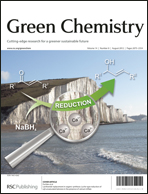Microwave barrel reactor use in trimethylolpropane oleate synthesis by Candida antarctica lipase in a biphasic non-solvent process†
Abstract
A novel microwave barrel reactor (MBR) was constructed and used in lipase catalyzed biolubricant synthesis. The MBR is thought as a versatile process tool for biotransformation and green chemistry that overcomes current size limitations in microwave reactors. A lipase mediated biotransformation in the MBR was compared to a state of the art jacketed reactor with external heat exchanger.


 Please wait while we load your content...
Please wait while we load your content...